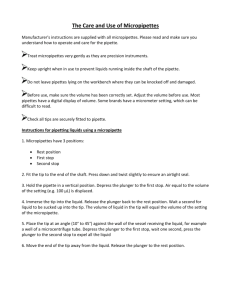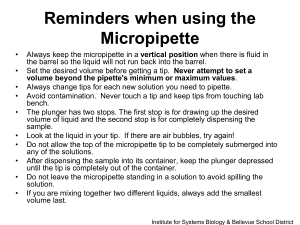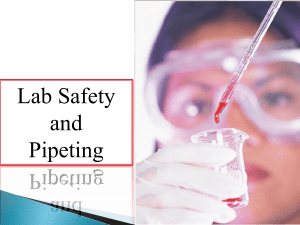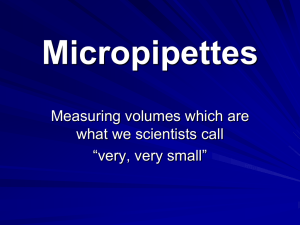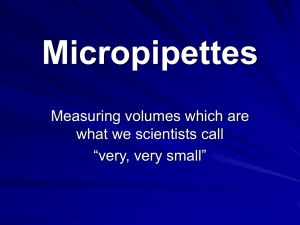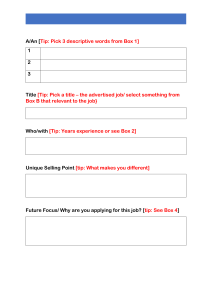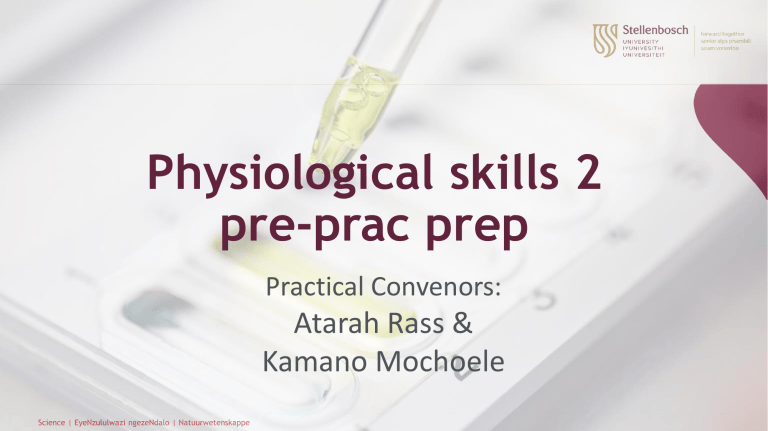
Physiological skills 2 pre-prac prep Practical Convenors: Atarah Rass & Kamano Mochoele Science | EyeNzululwazi ngezeNdalo | Natuurwetenskappe PIPETTES Science | EyeNzululwazi ngezeNdalo | Natuurwetenskappe Image created using biorender Plastic Pasteur pipettes Different means of measuring and transferring liquids in the lab Graduated, used for non-quantitative non-precise transfer Science | EyeNzululwazi ngezeNdalo | Natuurwetenskappe https://www.hiclipart.com/free-transparent-background-png-clipart-hpcnm/download Serological pipettes Different means of measuring and transferring liquids in the lab Science | EyeNzululwazi ngezeNdalo | Natuurwetenskappe Used for quantitative transfers Needs a vacuum source to aspirate (pipettor or bulb) Graduated in 1/10th of a mL up to 50 mL https://www.carlroth.com/at/en/single-use-pasteur-pipettes/serological-pipettes-rotilabo/p/n232.1 Micropipettes Different means of measuring and transferring liquids in the lab Science | EyeNzululwazi ngezeNdalo | Natuurwetenskappe Single channel used for highly accurate volume transfers Ranges from 0.1 µL to 10 mL https://theminione.com/product/one-series-micropipette-set-ea1010/ Volume adjustor Parts of a micropipette Science | EyeNzululwazi ngezeNdalo | Natuurwetenskappe Volumeter display Pipette etiquette These pipettes are not toys. They are top of the line, expensive equipment and we demand that you use them responsibly. Here are a few rules: 1. Always use a disposable tip and never draw any fluid into the white barrel (tip holder) of the pipette itself. The P-20 and P-200 use the yellow tips (sometimes clear) and the P-1000 use blue tips (sometimes clear). 2. Never lay a pipette down while there is fluid in the tip. The fluid may accidentally find its way into the barrel. 3. Never turn the volume adjuster below or above the full range settings. Science | EyeNzululwazi ngezeNdalo | Natuurwetenskappe How to set your pipette to the correct volume Science | EyeNzululwazi ngezeNdalo | Natuurwetenskappe 200-1000 uL pipette (Blue tips) First RED number is the thousands place of µL: 0350 µL 20-200 uL pipette (Yellow tips) First number is the hundreds place of µL: 095 µL 2-20 uL pipette (Yellow tips) First number is the tens place of µL; RED number is after the decimal: 02.5 µL How to correctly place your tip 1. Science | EyeNzululwazi ngezeNdalo | Natuurwetenskappe Open tip box 2. Firmly place pipette into tip and twist 90o before removing. 3. Close tip box Forward pipetting Step by step directions: 1. Set the desired volume. • Turn the volume up just a tiny bit past the desired setting, then down. 2. Attach a tip. • Press it on firmly, with a slight twisting motion. The tip must make an airtight seal with the pipette barrel. Do not tap or bang pipette into tip! *Hold pipette upright while pipetting - accuracy* 3. Depress the plunger to first stop. • Most people operate the plunger with their thumb 4. Insert the tip in the liquid you want to transfer. • Not far, just a bit below the surface; pre-wet tip by aspirating up and down twice. Science | EyeNzululwazi ngezeNdalo | Natuurwetenskappe https://www.microlit.us/faqs/what-are-the-different-techniques-of-pipetting/ 5. Release plunger s l o w l y . • Releasing the plunger suddenly may cause the pipette to underfill. • Also, be aware that the liquid level in the tube will drop as you withdraw fluid. Make sure that it doesn't drop below the level of the tip or you will suck air. 6. As you withdraw the tip, touch it to the side wall of the tube to remove excess fluid from the exterior. 7. To dispense, depress plunger slowly to the first stop; hesitate; then depress all the way. • Never dispense a small volume into thin air. Always dispense into a liquid or onto the wall of a tube so that adhesion will draw the expelled liquid off the tip. 8. Think about what to do with the pipette tip. Should you discard it or use it again? • "If in doubt, throw it out." Science | EyeNzululwazi ngezeNdalo | Natuurwetenskappe (Pushparaj, 2019) Important actions Effect of pipetting position on accuracy Correct droplet dispensing position INCORRECT Droplet hangs on tip rather than dispensing into tube Science | EyeNzululwazi ngezeNdalo | Natuurwetenskappe CORRECT Droplet adheres to the wall of the tube CORRECT Droplet dispersed directly into liquid in the tube Accuracy & Precision Percent Error = [(actualpredicted)/predicted] * 100% The purpose of calculating the percent error is to analyse how close the measured value is to an actual value. Science | EyeNzululwazi ngezeNdalo | Natuurwetenskappe
